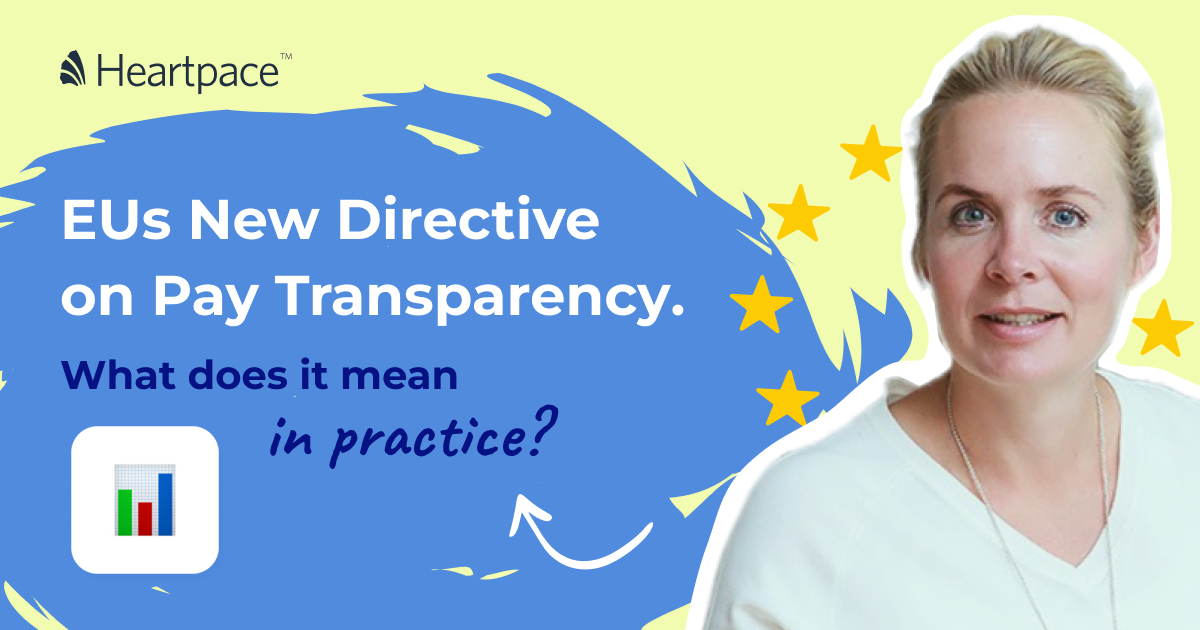The New EU Directive on Pay Transparency. What does it mean in practice?
1 Jun, 2023
5 min
The new EU Directive on Pay Transparency targets the pay differences between men and women that have been regulated at the EU level since 2006, but it has been challenging to implement and ensure compliance in the different member states.
In this article, we have asked our HR expert Elin to answer a few questions about the new EU directive on Pay Transparency.
Table of content:

Interview with Elin on Pay Transparency
Elin has a long experience in the field of Equal Pay requirements, and has been part of the planning, building and implementing three generations of Equal Pay Analysis tools. Elin’s knowledge in supporting equality in the work-life is substantial – and therefore our go-to-person.
Can you tell us a bit about this new directive?
This directive is about pay transparency to clarify better where pay differences between genders may exist.
Pay differences between men and women have been regulated at the EU level since 2006, but it has been difficult to implement and ensure compliance in the different member states.
One of the reasons why pay discrimination is difficult to detect is because the transparency of salaries and wage setting is often minimal.
Can you name a job seeker who has ever discovered the company’s salary policy before being asked, “What are your salary requirements”?
This lack of transparency makes understanding, detecting, and prosecuting pay discrimination difficult. People simply don’t realize that there are actually hidden differences.
This is why the EU prioritized pay transparency in the equal pay strategy. After the usual process, the European Parliament finally adopted the Pay Transparency Directive on 30 March 2023. EU countries now have three years to adapt and implement the legislation to their national circumstances.

Browse our webinar library!
We have a number of webinars about different HR related topics available to watch whenever you want.
What is the most challenging aspect of the new rules for HR?
— We who work in HR are very keen to do the right thing. Being “compliant” and following legal requirements is a matter of course for us. The challenge with new regulations is always to get the entire organization on board with why and how to live up to the requirements.
For example, much training will be required to make managers understand what is now required in the recruitment process, in interviews, and during employment.
— I also think I can see that there is a fear that these requirements may cause salary levels to be “compressed” so that there is less variation within a role. The employer wants to be able to differentiate based on the employee’s performance and contribution. This can be overcome with a wise and thoughtful job architecture that includes both junior and senior roles.
Is there anything in the directive that stands out or is controversial?
— Something that can be perceived as controversial is that the burden of proof is transferred to the employer, whereas it has traditionally been the employee’s responsibility to prove discrimination. In practice, this means that if an employee feels that he or she has been discriminated against in terms of pay, it is now the employer’s responsibility to explain and prove that this is not the case.
How do you think Swedish companies will receive the new directive?
— HR is generally very aware of the importance of equal pay as one of several ways to achieve a more equal society in the long run. Some of the reactions I have received about salary transparency are more practical questions about fulfilling these requirements. Then I usually reassure our customers who do the salary mapping in Heartpace and clarify how much they already have in place to be able to comply with the regulations.
Can you elaborate on what Heartpace provides in this compliance?
— The entire salary survey is based on a clear structure for the company’s roles through the job evaluation. This provides a practical and useful basis for demonstrating and transparently communicating the pay gap, pay levels, and career paths required by the Directive.
All the criteria used in setting salaries are also easy to track and communicate based on the information entered in the Salary Survey.
Furthermore, the fact that you can see in black and white where and in which roles differences need to be further analyzed provides the necessary basis for discussing measures and action plans with employee representatives.
What you can and cannot do – with the new Pay Transparency Directive
Below are the key points listed for your convenience!

Employers’ Dos and Don’ts
Employers must:
- Provide information on starting salary and salary ranges to employees and job applicants.
- Ensure that there is open access to average pay levels broken down by gender for equal or equivalent jobs.
- Make available pay and career progression criteria that are easily accessible, objective and gender-neutral.
- Conduct a joint review/action plan with workers’ representatives when the difference exceeds 5% and cannot be justified or explained.
- Report annually to the authorities if you have more than 250 employees.
- Companies with 150 to 249 employees should report every three years. Going forward (no later than two years after the implementation period), all companies from 100 to 249 employees will have to report every three years.
The Employer may not:
- Ask job applicants about their previous salary and their pay history.

Do you want to know more?
Book a demo here to see how Heartpace HR system can support equality in the workplace.
Explore more posts
Want to keep updated?
Subscribe to our blog posts, news and webinars here. We promise that we won’t overwhelm you with emails, nor will we never ever give your email address to anyone else!








